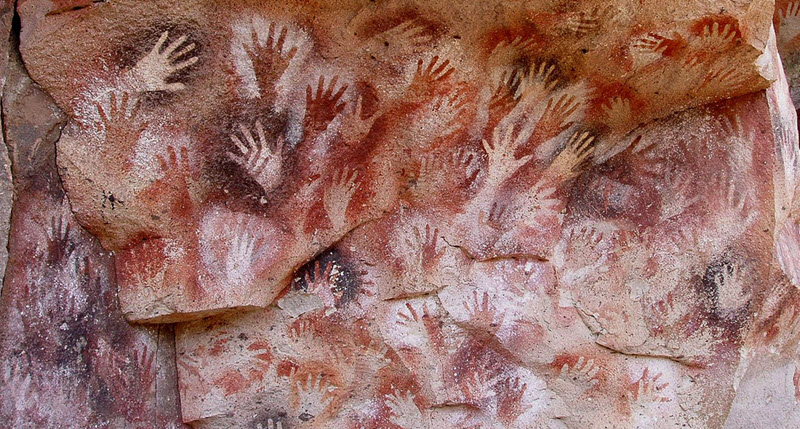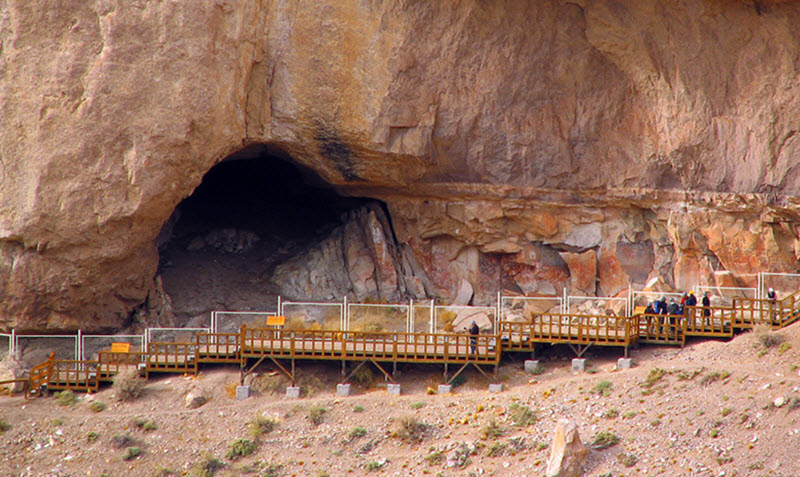Cueva de las Manos (Cave of the Hands) is a cave complex with an abundance of very old rock art located in the Santa Cruz province of Argentina. It is named after the hundreds of hand paintings stencilled into collages on the rock walls.
The oldest art in the cave complex has been dated to 11,000 – 7,000 years BCE, making it the oldest known cave paintings in all of South America. The dating is based on the remains of bone pipes used for spraying the paint over hands to create stencilled artwork.

Works of art are found not just inside the main cave, but also on the surrounding cliff faces and exterior. Similar paintings are also present in nearby caves.
A majority of the art is belongs to one of three categories: hands, depictions of humans, and depictions of animals (especially guanacos).
The site was declared a UNESCO World Heritage Site in 1999. It is also a listed National Historic Site (since 1939) and a National Historic Monument.
The cave complex is a part of the Cueva de las Manos Provincial Park and of the Perito Moreno National Park.
Short facts about the UNESCO World Heritage Site
Name: Cueva de las Manos, Río Pinturas
Reference: 936
UNESCO WHS criteria: Cultural: (iii)
Coordinates: 47°09′21″S 70°39′26″W
Area: 600 ha (1,500 acres)
Buffer zone: 2,331 ha (5,760 acres)
Visiting
To protect the site, visitors must be accompanied with an approved tour guide.
The cave complex is located in the valley of the Pinturas River, at the base of a cliff. The area has not been inhabited since circa 700 CE. The closest town, Perito Moreno, is found 165 km to the north.
There are three main access points:
– Estancia Cueva de las Manos
– Bajo Caracoles
– A midway access road between Estancia a Bajo Caracoles
A gravel road leaves Ruta 40 north of Bajo Caracoles and runs 43 km north-east to the south side of the Pinturas Canyon.
The cave complex
- The main cave, which is roughly 20 metres deep, is comprised of the main ”room”, two outcroppings, and the walls at either side of the entrance.
- The entrance is about 15 metres tall and 15 metres wide, and is facing north-east.
- When you first enter, the ceiling will be circa 10 meters above you, but the ground inside slopes upwards, so the deeper you go, the closer you will be to the ceiling. Eventually, the height is just 2 metres.
Annual celebration
In the closest town, Perito Moreno, an annual celebration is held in honour of the cave art. It is called Festival Folkólorico Cueva de las Manos.
Handprints
Over 2,000 depicted hands are found in and around the cave. A majority of them are painted as negatives or stencilled, but some are positive handprints. A survey in the 1970s that examined 860 of the hands found 829 left-hands and 31 right-hands.
Some of the hands are missing one or more fingers. We do not know if this means that the painter was actually missing a digit or digits, or if it is some form of sign language.

Animals
Examples of animals depicted on the walls are guanacos, rheas and felines.
Humans
Humans are depicted on the walls, and so is hunting scenes. The hunting scenes display a variety of hunting methods, including the use of bolas.
Other
In addition to the art mentioned above, the walls have also been adorned with geometric shapes, zigzag patterns, and representations of the sun. Red dots can be seen on the ceiling, and researchers have suggested that the painters submerged bolas in paint to make the dots.
Which pigments were used?
- Iron oxides to produce reds and purple
- Natrojarosite to produce yellow
- Copper oxide to produce green
- Kaolin to produce white
- Pyrolusite to produce black
Small amounts of green earth, goethite, and haematite have also been found.
We do not know which binder or binders that were used to make the paint.
